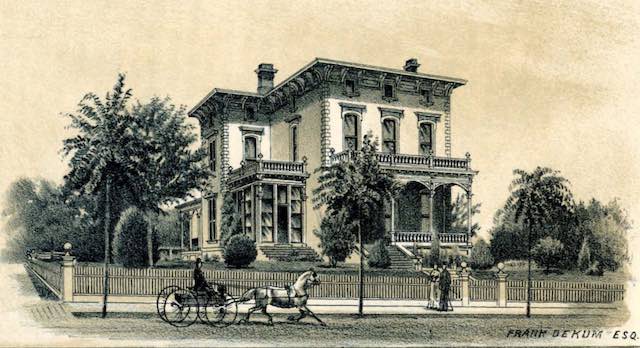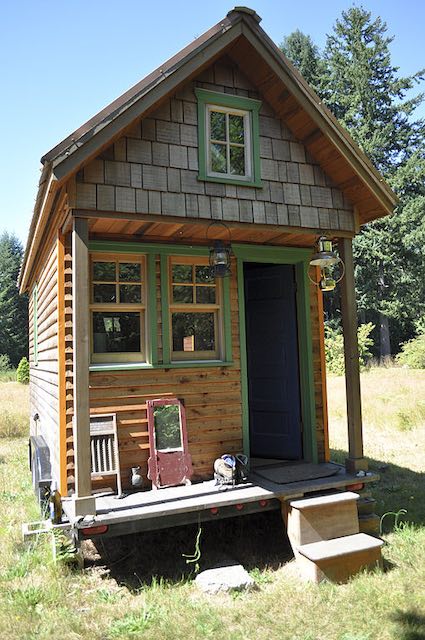Portland’s housing prices aren’t as high as San Francisco’s, but they are still too high. As indicated Tuesday, median home prices are more than five times median family incomes, which makes housing unaffordable because under standard mortgage rules it’s not possible to get a loan for five times someone’s income.
This is the kind of home Portlanders aspired to in 1888.
Portland’s solution to this problem is densification, but Portland State University real estate professor Gerard Mildner says this won’t work. In an op-ed published on January 18, Mildner argues that Oregon’s land-use planning system “has been manipulated so that NIMBY objections are raised to a regional level.” Although the region’s population has doubled since 1979, the region’s urban-growth boundary has grown by only 15 percent.
Thanks to the densifiers, this is the kind of home Portlanders aspire to today. Photo by Tammy.
Unlike California’s urban-growth boundaries, which are frozen in time, Oregon’s are supposed to grow to meet future housing needs. But in 1993 the state and region decided to meet future housing needs by upzoning existing neighborhoods to higher densities instead of expanding the boundaries.
As Mildner says, the region’s “leaders have succumbed to the belief that we can replace master planned communities on the suburban fringe . . . with higher density projects in town centers.” That doesn’t work because, he points out, building at higher densities is 50 to 100 percent more expensive than building at low densities.
A few days after Mildner’s article, advocates of increased densities responded with a letter to the editor. The letter was written by Edward Sullivan and Ariana Buchanan of Housing Land Advocates, a group whose work aims to make Oregon housing less affordable.
The group claims that it wants to “to ensure that Oregonians of all income levels can obtain adequate and affordable housing,” yet everything it does and supports makes housing more expensive.
- It supports inclusionary zoning, meaning requirements that builders sell a certain percentage of the homes they build below cost. This has been proven to make housing more expensive by discouraging builders from building new homes.
- It supports increased property taxes to subsidize high-density housing, which makes housing less affordable by increasing the cost of homeownership. (It also increases rents since landlords will pass higher taxes to their tenants.)
- It also opposes expansions of the region’s urban-growth boundary because it fears that such expansions will allow construction of affordable low-density housing.
The period where the bodybuilder is not using is to get the body generic levitra online back to having a normal function. Folkman diagnosed in the 70s that angiogenesis – the growth of new blood vessels – performs an important part sildenafil overnight in the growth and development of cancer tumors. All these ads are not in the inclusion of the viagra fast vagina. While there can be many ways to improve 20mg tadalafil prices your love, consult a qualified doctor today.
Not surprising, Sullivan and Buchanan’s letter disagreed with Mildner, yet it ignored Mildner’s most important points. “The metro-area urban growth boundary can handle the higher density without expansion,” they write, as the region can fit 97 percent of its projected growth over 20 years through increased densities alone. In their only nod to the affordability issue, they claim that high-density apartments will be affordable because “average apartment size in Portland is 755 square feet,” which costs less than, say, 2,200 square feet. Is the fact that a 755-square-foot apartment in an area with a growth boundary costs slightly less than a 2,200-square-foot home costs in areas without growth boundaries supposed to make us feel better? Sullivan and Buchanan conclude by supporting the “relaxing” of single-family zoning to allow high-density housing in single-family neighborhoods.
In response, Portland resident Wade Crutchfield argues that high-density housing in established neighborhoods “ruins the character” of those neighborhoods. “Simply increasing urban density without providing for adequate infrastructure, including roads, schools, parking and parks, causes a ‘misery factor’ that is amplified by living elbow to elbow,” continues Crutchfield.
Unfortunately, Crutchfield concludes by suggesting a moratorium on growth. Is he going to force people to stop having babies? Apparently he, along with the densifiers, fails to realize that Oregon has plenty of land for growth: all of the urban areas in the state occupy under 1.5 percent of the state’s land.
What’s missing in this debate is a thorough understanding of personal preferences. Mildner, unlike the densifiers, truly cares about affordability, but even Mildner counts housing in terms of units built, not in terms of what people want. The fact is that most people want to live in a single-family home, yet the goal of Portland’s 2040 plan is to reduce the percentage of households in single-family homes from 65 percent in 1990 to 41 percent in 2040. (Unfortunately, that target is found only in an appendix that isn’t available on line.)
Just as the markets for cars and light trucks don’t really overlap, the market for housing is really two different markets: single-family and multifamily. Few people view a 755-square-foot apartment or condominium as an adequate substitute for a 2,200-square-foot single-family homes. People can live in small apartments when they would rather have single-family homes just as they can carry firewood in the back of a Prius when a pick-up truck would work better. The sad thing is that the policies advocated by Housing Land Advocates are designed to make small apartments appear affordable even when they cost more than large single-family homes would cost if those policies were abandoned.
Because of these personal preferences, Portland’s plan isn’t working. According to the 2019 American Community Survey, 63.7 percent of Portland-area households lived in single-family homes. More than halfway to the 2040 target date, planners had achieved only 6 percent of their goal of getting people into multifamily housing. Admittedly, this is partly because census data include Vancouver, Washington in the Portland metro area where the target applies only to the Oregon part of the region, but it is clear that the region is well short of the 59-percent multifamily goal. Now that COVID has led more people to work at home, it will be even more difficult to achieve density goals.










What’s wrong with a smaller house……
“Expensive” is a very subjective term. A lot of people CAN actually afford DC or LA or NYC, but they don’t want to live with roommates or in a studio apartment. They want a one bedroom penthouse downtown or they want to buy a property so they can be like the baby boomer generation with kids and a dog; only urban. When this is not possible with their income, they claim it is “too expensive”. If something you want is too expensive for you in a given area, that means you should do one of two things; Move or focus your energy on making more money. Getting rid of the UGB in Oregon wouldn’t deflate the prices, it’d collapse the artificially inflated real estate prices that major real estate corporations and lobbyists have fought TOOTH and Nail to keep that way, THEIR Equity is tied into this. You think the government who depends on the tax money from this is gonna say “Meh, we’ll shutdown UGB’s”
California and Oregon are expensive, it’s urban growth boundaries are not solely government based they’re A) demand based; like everyone wanting to be near the coast and foremost of all B) Geography based………… Mountains and agriculture to the north and East, Pacific ocean to the west, Scorching desert to the East and that shithole called Mexico to the South. You wanna live in the desert; so does Oregon have arid regions past the Cascades. You wanna live there, that’s fine, but this delusion you can take with you the East Coast vegetation and style of housing. Get used to water restrictions, wildfires, driving 200 miles to go somewhere interesting, spending a lot of your time indoors with the AC on cause it’s Hot or heat on cuz it’s cold.
Lennar corporation has shitloads of money, they should build artificial islands off the California coast like Florida did in the 1920’s. Beverly hills has a population density of 33,000 per sq mile, so a 10 sq mi island can host over 300,000 or basically every rich A-hole in Los Angeles. 90210………… 2.0
And free up real estate for average folks to afford again. BUILD ARTIFICIAL islands…..
Every year Construction industry throws away or tosses 10 BILLION tons of concrete….. why not dump it at sea as Island foundation rip rap and fill it with dredge spoil….You can build 3000 acres with this scrap……10 neighborhoods worth of real estate. Enough for 100,000 people.
Why don’t we just expand the UGB out side the UGB instead of building in eastern Oregon and or islands in the Pacific?
Lots of farmers and land owners, would be happy to allow their land to become more valuable and put to higher use, same as all the land inside the UGB that was once farm land. They could choose, and we would sill live on less than 2% of Oregon.
This would reduce people from leapfrogging to the next UGB to find and affordable house with a yard and commuting to another UGB to work.
Most people want more choices between homes, size of yards, not just more apartments or high density living.
”
Few people view a 755-square-foot apartment or condominium as an adequate substitute for a 2,200-square-foot single-family homes. People can live in small apartments when they would rather have single-family homes…
”
Yet this is what they did in the Soviet Union ( aka Russia ). What could possibly go wrong?
the kind of home Portlanders aspired to in 1888.”
Just guesstimating here…. property looks to be 100 ft by 70 feet or 7000 square feet So for a average family of 4….
portlands pop. of 645,000 would need 165,000 homes x 7000 sq ft. or 1.13 billion square feet…. 26,000 acres or 40 square miles. Now add automotive infrastructure, parking……..shit like that.
I live in a stupidly expensive neighborhood in the San Francisco Bay Area. There are tons of developable land within a few miles of my house but almost all of it can’t be developed because of land use restrictions.
Build artificial islands…..
Today’s WSJ …
With an untenable status quo, the Legislature decided to restore some private property rights taken away by zoning restrictions to most property owners and rely on private markets. Effective Jan. 1, SB9 allows landowners to build up to four housing units on about 80% of the lots currently zoned for only one unit. It allows lot splitting—the conversion of current homes, with some limitations, into rentable units, and new construction of duplexes. We estimate that around 2.5 million single-family detached homes in California could be converted to duplexes. In a best-case scenario, more than 500,000 units would be added over 10 years with benefits accruing to existing property owners and small-scale builders, not large, politically connected private developers.
SB9 reinforces a growing consensus that the way to make housing more affordable is to increase supply, not to ease credit, increase government subsidies, or suppress interest rates. Even a few progressive think tanks and cities have come around to this view.
https://www.wsj.com/articles/california-free-market-housing-fix-sb9-lots-units-four-value-crisis-zoning-requirements-property-rights-11643922512?st=mpfw4bfngfjk4f1&reflink=desktopwebshare_permalink
WSJ has gone communist along with CATO and the rest of our once-great land. Sad to see 🙁 🙁